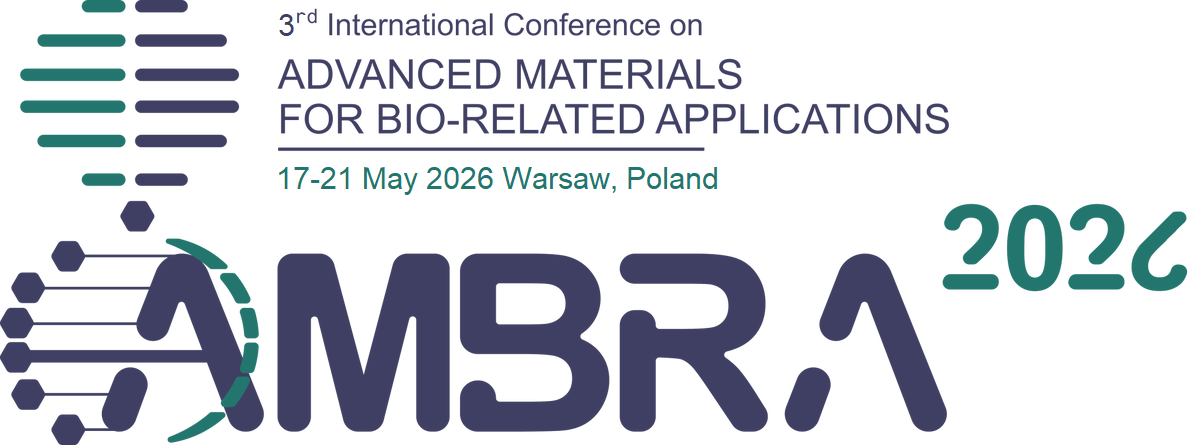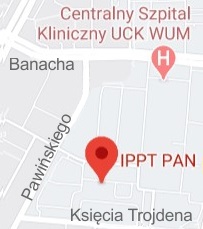| 1. |
Kowalski A.♦, Piros T.♦, Błoński S., Kurniawan T., Korczyk P., Hołyst R.♦, Microfluidic-based platform for the semi-automated study of concentration, diffusion, and equilibrium binding of biomolecules,
Chemical Engineering Journal, ISSN: 1385-8947, DOI: 10.1016/j.cej.2025.169512, Vol.524, pp.169512-1-10, 2025 Abstract:
We introduce a novel microfluidic-based platform that automates single-molecule-sensitive measurements of biomolecular interactions using Fluorescence Correlation Spectroscopy (FCS) combined with FRET and Molecular Brightness Analysis (MBA). The developed system allows for the simultaneous analysis of biomolecule concentration, diffusion coefficient, and equilibrium constant in nanoliter-volume droplets. At the same time, it speeds up the measuring procedure by 5 times compared to the standard one, reduces reactant consumption by 2000 times compared to conventional cuvette-based FCS measurements, and limits the researcher’s intervention to setting up the experiment and calibrating the microscope. We show the performance of the platform by studying DNA–DNA complex formation in response to ionic strength changes, as well as interactions of idarubicin with various nucleic acid complexes. The proposed solution paves the way for the automated optimization of non-covalent reaction conditions, leveraging non-invasive, high-precision statistical methods. Keywords:
Fluorescence correlation spectroscopy, Microfluidics, Biomolecular interactions, Automation, Diffusion coefficient, Equilibrium constant, DNA hybridization Affiliations:
| Kowalski A. | - | other affiliation | | Piros T. | - | other affiliation | | Błoński S. | - | IPPT PAN | | Kurniawan T. | - | IPPT PAN | | Korczyk P. | - | IPPT PAN | | Hołyst R. | - | other affiliation |
|  |
| 2. |
Krysiak Z., Rybak D., Kurniawan T., Zakrzewska A., Pierini F., Light-Driven Structural Detachment and Controlled Release in Smart Antibacterial Multilayer Platforms,
Macromolecular Materials and Engineering, ISSN: 1438-7492, DOI: 10.1002/mame.202400462, Vol.310, No.7, pp.2400462-1-9, 2025 Abstract:
Smart materials, especially light-responsive, have become a key research area due to their tunable properties. It is related to the ability to undergo physical or chemical changes in response to external stimuli. Among them, photothermal responsive materials have attracted great interest. This study focuses on the development of a multilayer system (MS) consisting of benzophenone-modified polydimethylsiloxane (PDMS) ring and a thermo-responsive core made of poly(N-isopropylacrylamide-co-N-isopropylomethacrylamide) (P(NIPAAm-co-NIPMAAm)), gelatin, and gelatin methacrylate (GelMA). The system utilizes the thermal sensitivity of P(NIPAAm-co-NIPMAAm) and the photothermal effect of gold nanorods (AuNRs) to achieve an on-demand controlled release mechanism within 6 min of near-infrared (NIR) light irradiation. The mechanical properties investigated in the compression test show significant improvement in MS, reaching 60 times greater value than the material without a PDMS ring. In addition, NIR irradiation for 15 min activated the antimicrobial properties, eliminating 99.9% of E. Coli and 100% of S. Aureus, thus presenting pathogen eradication. This platform provides a versatile methodology for developing next-generation smart materials, advanced delivery mechanisms, and multifunctional nanostructured composites. This work highlights the potential of photosensitive materials to revolutionize the field of soft robotics, optics and actuators, and on-demand systems by providing precise control over release dynamics and improved material properties. Affiliations:
| Krysiak Z. | - | IPPT PAN | | Rybak D. | - | IPPT PAN | | Kurniawan T. | - | IPPT PAN | | Zakrzewska A. | - | IPPT PAN | | Pierini F. | - | IPPT PAN |
|  |
| 3. |
Dumbill R.♦, Rabcuka J.♦, Fallon J.♦, Knight S.♦, Hunter J.♦, Voyce D.♦, Barrett Jacob T.♦, Ellen M.♦, Weissenbacher A.♦, Kurniawan T., Błoński S., Korczyk P.M., Ploeg Rutger J.♦, Coussios C.♦, Friend P.♦, Świętach P.♦, Impaired O2 unloading from stored blood results in diffusion-limited O2 release at tissues: evidence from human kidneys,
Blood, ISSN: 0006-4971, DOI: 10.1182/blood.2023022385, Vol.143, No.8, pp.721-733, 2024 Abstract:
The volume of oxygen drawn from systemic capillaries down a partial pressure gradient is determined by the oxygen content of red blood cells (RBCs) and their oxygen-unloading kinetics, although the latter is assumed to be rapid and, therefore, not a meaningful factor. Under this paradigm, oxygen transfer to tissues is perfusion-limited. Consequently, clinical treatments to optimize oxygen delivery aim at improving blood flow and arterial oxygen content, rather than RBC oxygen-handling. Whilst the oxygen-carrying capacity of blood is increased with transfusion, previous studies have shown that stored blood undergoes kinetic attrition of oxygen release, which may compromise overall oxygen delivery to tissues, i.e. transport became diffusion-limited. We sought evidence for diffusion-limited oxygen release in viable human kidneys normothermically perfused with stored blood. In a cohort of kidneys that went on to be transplanted, ex-vivo renal respiration correlated inversely with the time-constant of oxygen-unloading from RBCs used for perfusion. Furthermore, the renal respiratory rate did not correlate with arterial O2 delivery unless this factored the rate of oxygen-release from RBCs, as expected from diffusion-limited transport. In kidneys deemed unsuitable for transplantation, perfusion was alternated between stored and rejuvenated RBCs of the same donation to control oxygen-unloading without intervening ischemia and holding all non-RBC parameters constant. Rejuvenated oxygen-unloading kinetics reversibly improved the kidney's oxygen diffusion capacity and increased cortical oxygen partial pressure by 60%. Thus, oxygen delivery to tissues can become diffusion-limited during perfusion with stored blood, which has implications in scenarios such as ex-vivo organ perfusion, major hemorrhage, and pediatric transfusion. Affiliations:
| Dumbill R. | - | other affiliation | | Rabcuka J. | - | other affiliation | | Fallon J. | - | other affiliation | | Knight S. | - | other affiliation | | Hunter J. | - | other affiliation | | Voyce D. | - | other affiliation | | Barrett Jacob T. | - | other affiliation | | Ellen M. | - | other affiliation | | Weissenbacher A. | - | other affiliation | | Kurniawan T. | - | IPPT PAN | | Błoński S. | - | IPPT PAN | | Korczyk P.M. | - | IPPT PAN | | Ploeg Rutger J. | - | other affiliation | | Coussios C. | - | other affiliation | | Friend P. | - | other affiliation | | Świętach P. | - | other affiliation |
|  |
| 4. |
Kurniawan T., Sahebdivani M.♦, Zaremba D., Błoński S., Garstecki P.♦, van Steijn V.♦, Korczyk P.M., Formation of droplets in microfluidic cross-junctions at small capillary numbers: Breakdown of the classical squeezing regime,
Chemical Engineering Journal, ISSN: 1385-8947, DOI: 10.1016/j.cej.2023.145601, Vol.474, pp.14560-14560, 2023 Abstract:
Two decades of research on droplet formation in microchannels have led to the widely accepted view that droplets form through the squeezing mechanism when interfacial forces dominate over viscous forces. The initially surprising finding that the volume of the droplets is insensitive to the relative importance of these two forces is nowadays well understood from the constrained deformation of the droplet interface during formation. In this work, we show a lower limit of the squeezing mechanism for droplets produced in microfluidic cross-junctions. Below this limit, in the leaking regime, which was recently discovered for droplets produced in T-junctions, the volume of the produced droplets strongly depends on the relative importance of interfacial and viscous forces, as captured by the capillary number. We reveal a fundamental difference in the mechanisms at play in the leaking regime between T- and cross-junctions. In cross-junctions, the droplet neck elongates substantially, and unlike the case of the T-junction, the magnitude of this elongation depends strongly on the value of the capillary number. This elongation significantly affects the final droplet volume in a low capillary number regime. Generalizing the classical squeezing law by lifting the original assumptions and incorporating both identified mechanisms of leaking through gutters and neck elongation, we derive a model for droplet formation and show that it agrees with our experiments. Keywords:
Microfluidics,Cross-junction,Flow-focusing device,Droplet formation,Two-phase flow,Scaling law,Squeezing regime Affiliations:
| Kurniawan T. | - | IPPT PAN | | Sahebdivani M. | - | other affiliation | | Zaremba D. | - | IPPT PAN | | Błoński S. | - | IPPT PAN | | Garstecki P. | - | Institute of Physical Chemistry, Polish Academy of Sciences (PL) | | van Steijn V. | - | Delft University of Technology (NL) | | Korczyk P.M. | - | IPPT PAN |
|  |
| 5. |
Kurniawan T., Tsai P.H.♦, Chen S.S.♦, Frakes D.H.♦, Chen C.C.♦, Wang A.B.♦, Practical notes toward higher quality and more reliable experiments on drop and liquid surface interactions,
Experiments in Fluids, ISSN: 0723-4864, DOI: 10.1007/s00348-021-03346-w, Vol.63, No.1, pp.8-1-27, 2022 Abstract:
Reliable experimental data are essential for good research. Also, the interaction of drop and liquid surface is ubiquitous and of practical importance in our lives. However, beginning researchers often face an unavoidable long learning curve due to a lack of systematic collection of failure experiences. These include somewhat trivial but also influential factors, especially in cases of low impact velocities, e.g., the feeding process into a liquid tank, the dropping into a drip chamber, and/or neglecting the initial velocity associated with the dripping drop generation in the experimental preparation processes, etc. Inconsistent experimental comparisons may arise from different methods of thin-film preparation and measurement or from nonunified parameter definition, e.g., the penetration depth of vortex rings induced by low-velocity drop impact, which makes experimental data analysis and comparison even more challenging. Here, we have accumulated some of our experience in preparing drop and liquid surface interactions including a short review of preparing thin (or very thin) target liquid film of well-defined thickness; the method to minimize the commonly neglected current underneath the target liquid; the method of generating the satellite-free drop along with the correct prediction of drop oscillation phase in the free-falling period after pinch-off, and the role of drop initial velocity, etc. These archival data are expected to shorten the learning period and facilitate benchmarking of related experiments for future users in our community. Affiliations:
| Kurniawan T. | - | IPPT PAN | | Tsai P.H. | - | National Taiwan University (TW) | | Chen S.S. | - | National Taiwan University (TW) | | Frakes D.H. | - | National Taiwan University (TW) | | Chen C.C. | - | National Taiwan University (TW) | | Wang A.B. | - | National Taiwan University (TW) |
|  |
| 6. |
Suwa T.♦, Kurniawan T., Redesigning a commercial combined cycle in an undergraduate thermodynamics course: connecting theory to practical cycle design,
International Journal of Mechanical Engineering Education, ISSN: 0306-4190, DOI: 10.1177/0306419020904647, pp.1-20, 2020 Abstract:
Due to various reasons, the concepts of thermodynamics are not easy to grasp for undergraduate students. One of the major reasons is that the students are mostly unfamiliar with the thermodynamics devices discussed in the courses. Offering courses with experiments is an effective approach to solve this issue. However, it is not practical or possible for universities to own devices that operate at high temperatures and with high pressure fluids. With the cooperation of a nearby electric company, undergraduate students of a thermodynamics course from the Department of Mechanical Engineering measured thermal performances of a commercial combined cycle and its sub-systems at the President University. After learning about the theory of thermal cycles, the students analyzed the thermal performances of actual thermodynamics cycles. Subsequently, they analyzed the thermal efficiency improvements when reheating or regeneration is applied to the simple Rankine cycle in the combined cycle. At the end of the course, the students gave presentations before the electric company’s management and engineering personnel, akin to professional engineers. This course is structured to familiarize undergraduate students with thermodynamics cycles and devices. Keywords:
thermodynamics, combined cycle, Brayton cycle, gas-turbine engine, Rankine cycle Affiliations:
| Suwa T. | - | President University (ID) | | Kurniawan T. | - | IPPT PAN |
|  |
| 7. |
Tsai P.♦, Kurniawan T.♦, Wang A.♦, A simple technique to achieve meniscus-free interfaces,
PHYSICS OF FLUIDS, ISSN: 1070-6631, DOI: 10.1063/1.5080659, Vol.31, No.1, pp.011702-1-9, 2019 Abstract:
Liquid wetting on a container wall forms a meniscus that causes the reading uncertainty of interface measurement, which was considered as an “inevitable” interference in experiments. For minimizing the meniscus interference, the dynamic instead of the static contact angle should be focused on and θr ≤ 90° ± ε ≤ θa is the guideline to achieve a meniscus-free interface for a practical experiment, where θr, θa, and ε are the receding and advancing contact angles, and image measuring uncertainty, respectively. A simple and systematic technique to achieve the meniscus-free interface has been proposed and visualized. Keywords:
Thermal instruments, Liquids, Fluid dynamics, Flow visualization, Capillary flows Affiliations:
| Tsai P. | - | National Taiwan University (TW) | | Kurniawan T. | - | other affiliation | | Wang A. | - | National Taiwan University (TW) |
|  |
| 8. |
Wang A.♦, Cheng C.♦, Lin I.♦, Lu F.♦, Tsai H.♦, Lin C.♦, Yang C.♦, Pan P.♦, Kuan C.♦, Chen Y.♦, Lin Y.♦, Chang C.♦, Wu Y.♦, Kurniawan T.♦, Lin C.♦, Wo Andrew M.♦, Chen L.♦, A novel DNA selection and direct extraction process and its application in DNA recombination,
Electrophoresis, ISSN: 0173-0835, DOI: 10.1002/elps.201000449, Vol.32, pp.423-430, 2011 Abstract:
In the conventional bench-top approach, the DNA recombination process is time- and effort-consuming due to laborious procedures lasting from several hours to a day. A novel DNA selection and direct extraction process has been proposed, integrated and tested on chip. The integrative microfluidic chip can perform the whole procedure of DNA recombination, including DNA digestion, gel electrophoresis, DNA extraction and insert-vector ligation within 1 h. In this high-throughput design, the manual gel cutting was replaced by an automatic processing system that performed high-quality and high-recovery efficiency in DNA extraction process. With no need of gel-dissolving reagents and manipulation, the application of selection and direct extraction process could significantly eliminate the risks from UV and EtBr and also facilitate DNA recombination. Reliable output with high success rate of cloning has been achieved with a significant reduction in operational hazards, required materials, efforts and time. Keywords:
Chip integration, DNA recombination, DNA selection and extraction , Microfluidics Affiliations:
| Wang A. | - | National Taiwan University (TW) | | Cheng C. | - | other affiliation | | Lin I. | - | other affiliation | | Lu F. | - | other affiliation | | Tsai H. | - | other affiliation | | Lin C. | - | other affiliation | | Yang C. | - | other affiliation | | Pan P. | - | other affiliation | | Kuan C. | - | other affiliation | | Chen Y. | - | other affiliation | | Lin Y. | - | other affiliation | | Chang C. | - | other affiliation | | Wu Y. | - | other affiliation | | Kurniawan T. | - | other affiliation | | Lin C. | - | other affiliation | | Wo Andrew M. | - | other affiliation | | Chen L. | - | other affiliation |
|  |




























